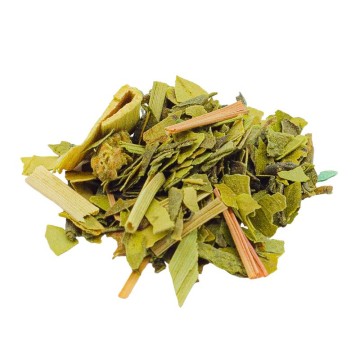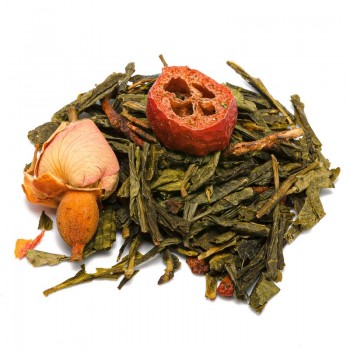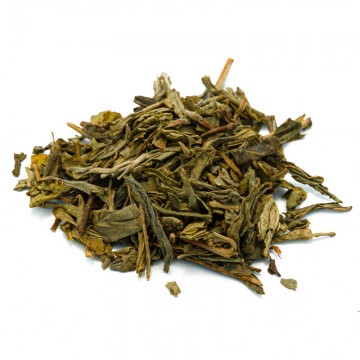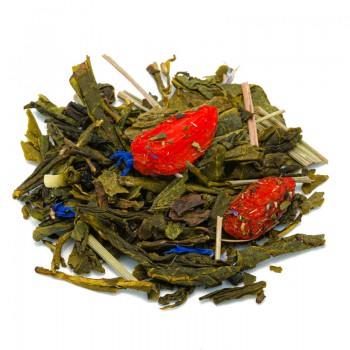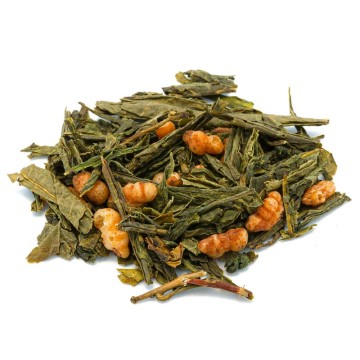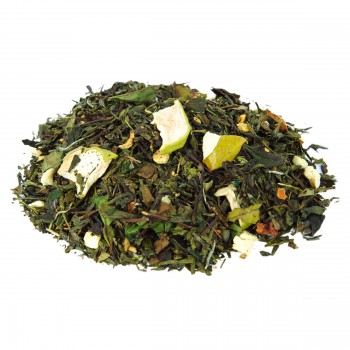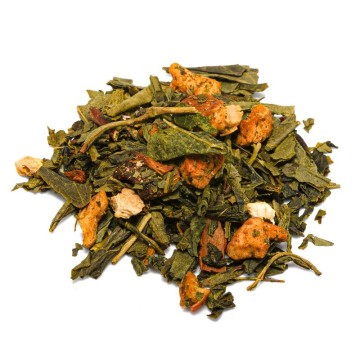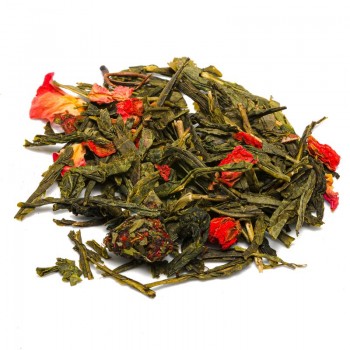Mint green tea
The refreshing fragrance of mint joins that of tea, in an excellent pair for its many benefits. This delicious and aromatic tea is known for its healthy characteristics on the digestive system, as a support for the correct assimilation of food, in the stomach and intestinal transit. In terms of taste, this drink shows a strong character, thanks to the marked aroma of mint leaves.
The summer note of mint adds to the velvety and light flavor of green tea. In its original natural flavor it leaves a fresh aftertaste, perceptible even by adding a little sugar. Pleasant to taste at any time of the day, it can be served cold as a refreshing tea in the summer. It is also used as a base for fruit iced tea.
Properties and benefits
Enjoyed all over the world, green tea leaves boast excellent virtues for our well-being. Compared to other teas, they contain the highest number of polyphenols: powerful antioxidants found in nature. When the benefits of tea and mint are combined, an infusion full of virtues comes out. Along with the properties of tea, mint leaves also offer support to digestive well-being. This combination helps the proper digestion of food, thanks to the mint leaves that contain menthol.
This oily compound, often used for its pungent flavor and aroma, is useful for calming the symptoms of nausea, diarrhea , indigestion and other digestive disorders. The calming effect of menthol relaxes the stomach muscles, especially as digestive waste passes through the intestines. It can help relieve the symptoms caused by irritable bowel syndrome. Mint is considered one of the best herbs for the digestive system, because it promotes the secretion of digestive juices and reduces gastric gas.
A green tea with mint works by stimulating the digestive system, and is also effective in counteracting the feeling of nausea associated with motion sickness. Green tea with mint can facilitate digestion and correct metabolism, thanks also to the minerals it contains: potassium, zinc, magnesium, vitamin C and manganese. These are elements that facilitate healthy digestion, and also help keep the cardiovascular system healthy and the skin beautiful. Other substances contained in mint (terpenes) in phytotherapy are traditionally associated with the health of the liver and gallbladder, in a purifying key. In fact, for our well-being, the detox effect of green tea continues even after digestion, acting beneficially on diuresis to facilitate the elimination of toxins.
It also helps regulate the sugar level after a meal, increasing the metabolism. Certain polyphenols in green tea including epigallocatechin gallate (EGCG), can enhance levels of fat oxidation (fat burning) and the rate at which the body converts food into calories. The process is also useful for digestion: green tea with its contribution of mint becomes a resource for the gastrointestinal system, and to facilitate weight loss (as part of a correct diet). The freshness of the flavor of this drink is also useful for the well-being of the oral cavity and teeth.
In fact, mint leaves contain antioxidants that combine with the natural fluoride in green tea leaves. For this reason, a cup of green tea with mint after meals counteracts harmful bacteria for the oral cavity, as well as leaving the mouth fresh and perfumed. This element is also useful for smokers, who can use the green tea and mint drink to soothe the throat and freshen the breath. Peppermint green tea offers several antioxidants and at the same time relaxes, supporting the well-being of our immune system. It was used historically to relieve headaches and symptoms related to the common cold.
Origins and History of cultivation
The tea plant is native to areas of East Asia, the Indian subcontinent and Southeast Asia. Today it is grown worldwide in tropical and subtropical regions. The name of the plant, Camellia, derives from the surname of the Reverend Georg Kamel (1661-1706), a lay Jesuit, pharmacist and missionary in the Philippines, who studied oriental plants for a long time. Sinensis means Chinese, given the enormous diffusion of this plant in China. According to legend, around 2700 BC. Chinese Emperor Shennong mistakenly drank water in which a dry tea leaf had been boiled.
The taste seemed refreshing to him, and thus a new drink was born. In fact, we know that green tea was used prinmainly for the elites of Chinese society, very expensive to buy. Only in the fourteenth century did it become accessible to all, both for the pleasure of sipping it and for its medicinal qualities. His virtues were described around 800 AD. by Lu Yu, who wrote a book entitled "Cha Jing" or The Classic of Tea. Adopted as a child by a Buddhist monk, the author grew up making and serving tea, and over the years he described his discoveries. The Tea Classic became the first work explaining the culture and art of green tea.
Tea arrived in the West in the 19th century via European explorers, particularly the British, and given its incredible flavor was a precious and sought-after food. It became the national drink of Great Britain, along with black tea. In recent decades, the popularity of green tea has steadily increased, as its flavor and antioxidant properties are highly coveted. This blend also features another important ingredient, mint. Used since ancient times for its culinary and therapeutic qualities and for its perfume, it is a plant native to Europe and Asia. Over time it has naturalized in northern and western Africa, in North America and in various oceanic islands. A Greek myth tells that the term derives from the nymph Mentha, daughter of the god of rivers Cocito and lover of Pluto
. His wife Persephone, jealous of this love, transformed Menthe into a plant that clung to the ground. Pluto gave her the ability to sweeten the air with her scent. In fact, it is famous for its characteristic smell: one of the most used aromatic herbs in the world to purify the air, in temples and homes.
It also represents hospitality, as it welcomed guests in classical Greece. Even today in the Middle East, tradition has it that the landlord immediately prepares mint tea for the guests. It is very popular in North Africa, especially Moroccan mint tea, although the Gunpowder variety of green tea is often used. Various populations used it for its medicinal properties, such as the Native Americans, in particular to promote digestion, dental health and as a hot infusion for colds. In modern times, mint or menthol oil is used as a flavoring agent in various dental hygiene products (mouthwashes, toothpastes, chewing gums). In classic herbal medicine, mint extracts give relief to stomach ailments, intestinal colic, nasal congestion, headaches, and inflammation of the gums.
Plant and flowers
Camellia sinensis, known as the tea plant, is a species of evergreen woody shrub in the Theaceae family. Different varieties of tea are obtained from its leaves, including green tea. The difference is given by the processing, to reach various levels of oxidation; the leaves are always those of the Camellia sinensis.
Four varieties of Camellia sinensis are recognised, of which C. sinensis var. sinensis and C. sinensis var. assamica (JW Masters) Kitamura are the most used for tea production. The plant grows to 16 meters but is usually cut back to less than 2 meters in height to facilitate hand picking, which is repeated every 1-2 weeks. Tea grows best in cool, humid tropical highlands and evergreen deciduous forests. It prefers sandy and clayey, well-drained soils.
The famous leaves can stretch up to 15 cm, with different shapes based on the variety. The young, light green leaves are preferred for harvesting - the different ages of the leaves produce different qualities of tea, due to the changing chemical composition. The flowers are white, fragrant, grow alone or in clusters, and are hermaphroditic (they have male and female organs). Mint or Mentha is a herbaceous and perennial plant of the Lamiaceae family. It is very widespread, also thanks to the many varieties, up to 24 species, all with similar herbal properties.
Many mint hybrids are renowned, mainly used for food. It grows to about 1-2 meters in height, with sometimes hairy stems and foliage. It has a fleshy underground root (rhizome). The leaves are up to 9 cm long and show a serrated margin. Like many plants in the mint family, they have square-shaped stems. The flowers are born in thin spikes.
Nutritional values of Green Tea with Mint
Green tea with mint contains a powerful antioxidant called EGCg (epigallocatechin gallate). Furthermore, it shows different levels of potassium, zinc, iron, magnesium and manganese. It makes available methylxanthines (caffeine, theobromine, theophylline), vitamin C and B vitamins (thiamine, riboflavin, niacin). Mint adds toThe infusion contains menthol (mint oil), vitamins E, A and beta-carotene.
How to prepare mint green tea
The infusion is obtained by placing in a cup (250 ml), about 3-5 grams of the blend of green tea and mint with water at 80 °C. Let it steep for 2 to 3 minutes before drinking this green tea. Add honey or sugar, if desired.
Green tea with mint: side effects and contraindications
Green tea can cause some side effects if the recommended doses are not respected. The content of theine (caffeine) can trigger disorders if it is taken in excessive quantities, causing nervousness, anxiety, insomnia, rapid heartbeat. Also, high doses of tea could affect thyroid functioning.
In some cases they can cause liver fatigue, therefore it is advisable to consult a specialist in case of chronic pathologies. For those suffering from gastroesophageal reflux, mint tea can aggravate the symptoms, due to the stimulation of gastric juices and the relaxation of the stomach sphincter muscles. In some cases peppermint tea can trigger reactions in those who are allergic to menthol. Caution is advised during pregnancy and while breastfeeding.

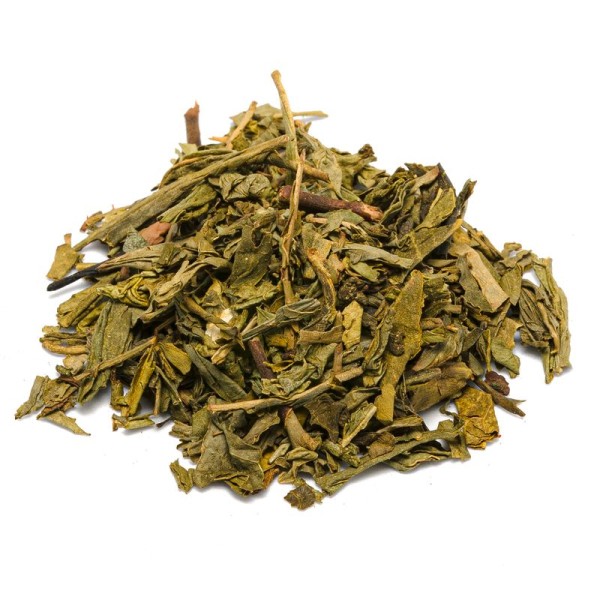









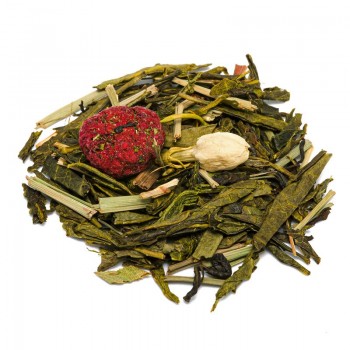
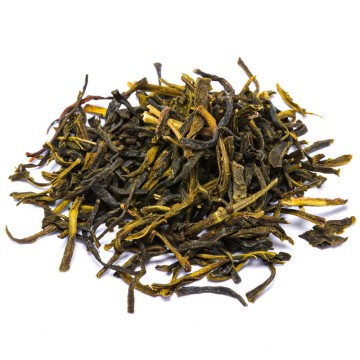
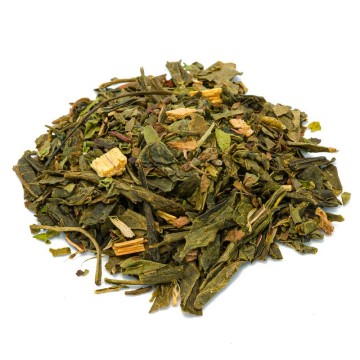
![green tea hemp mango [Natura d'Oriente]](https://www.naturadoriente.com/3381-home_default/green-tea-hemp-and-mango.jpg)
